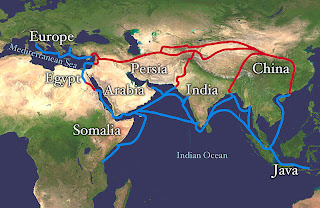Heritage, Spices and River – All In Melaka
 |
| Source http://en.wikipedia.org/wiki/File:Silk_route.jpg#filelinks |
People all over the world used condiments that yield
fragrant and taste to foods. Navigators attempt on a sea route to India in
search of pepper during the Middle Ages. See the Spices Trade Route (Garis Peta Perjalanan Perdagangan Rempah).
We used the seeds, bark, leaves and rootstock of a variety
of plants to promote our dishes on the tables. Grow wild in East Indies,
cultivated not only in India but also in Sumatra, Java and Borneo, black pepper
and white pepper is stock in homes of the Chinese, Malay, Hindu, Portuguese,
Eurasean, and is an important condiment of the Baba-Nyonya.
They have shared ways of preserving the pepper sharpest
flavor. When I visited my teacher, I asked him, “Sir, could you tell me about the origin of Baba-Nyonya ?”
He summarized the long history in two minutes. “They are Chinese people with origin in
China. They landed in Singapore, Melaka and Penang. They worked hard and became
successful. They’ve got house servants from Sumatra and they emulated the
Sumatran cooking methods. Inter-marriages was natural and members of the family
began to learn the servants’ language and started to speak to each other in the
Sumatran Malay Language. With a large home as you can see the lengths of the
houses with its front contouring a street to its back-yard bordering another
street, they added Amah Jie to their team of house servants. They began to
learn to speak the Cantonese dialect while enjoying the sumptuous cuisine of
Southern China. The Amah Jies are emigrants from Guangdong. Beside, soy sauce, rice wine, vinegar, and
sesame oil; ginger, turmeric, chili peppers, black peppers top the ingredients
list of the Cantonese chefs. We were
sent to English schools in Melaka. So, we can speak Malay, Cantonese and
English Language.”
Another type of favourite spice of the locals the Cayenne
which is a capsicum or chilli. (The spelling of the spice, Cayenne is the same
as that of Porsche Cayenne). Cayenne is not only an important part of curry
mixture but is also useful for seasoning meats, fish and sauces. Grinding
Cayenne in curry mixture with a pastle and a mortar produces fanstatic paste
together with ginger, cumin, cardamom, mustard and coriander. At a distance
beyond the concrete fencing of a Hindu home, where the sound of the grinding
could be heard and not seen, the sharpest fragrant from the raw paste has
tickle my nostrils everytime. Curry is eaten at least one time in a day by the
Hindus, and regularly by the Chinese, Baba-Nyonya,
Malay, Portuguese and Eurasean. You will find delicious Laksa everywhere in Melaka and the fragrant curry not only in every
homes of the Malaccans but also many in the Far East.
See the spices, feel the
species with your hands and taste the spices in Little India, Melaka.
 |
| Source : http://en.wikipedia.org/wiki/File:409841087_b7bcac1bd5_o.jpg |
And if do not try the Melaka River Cruise, you will never
discover that the Spice Garden or Taman
Rempah is connecting the rich old unchanged, buildings, landscape and
history of the UNESCO heritage zone along the lower river with the modern and
new changing buildings, landscape and beuatifications along the upper river.
Perhaps, Admiral Zheng He and his Treasure Fleet would reveal more of the Spice
Trade Route at the Zheng He Gallery on the Hill of Saint Paul.
Make sure you enjoy the heritage, spices and the river
whenever you are in Melaka. Perhaps, if you grant me to suggest, Everytime !
Enjoy this song, Everytime by Britney Spears.
Check Out more at museums provided by the Perbadanan Muzium Melaka.
contributed by
a former pupil of Malacca High School
for Melaka and Malaccans




Comments